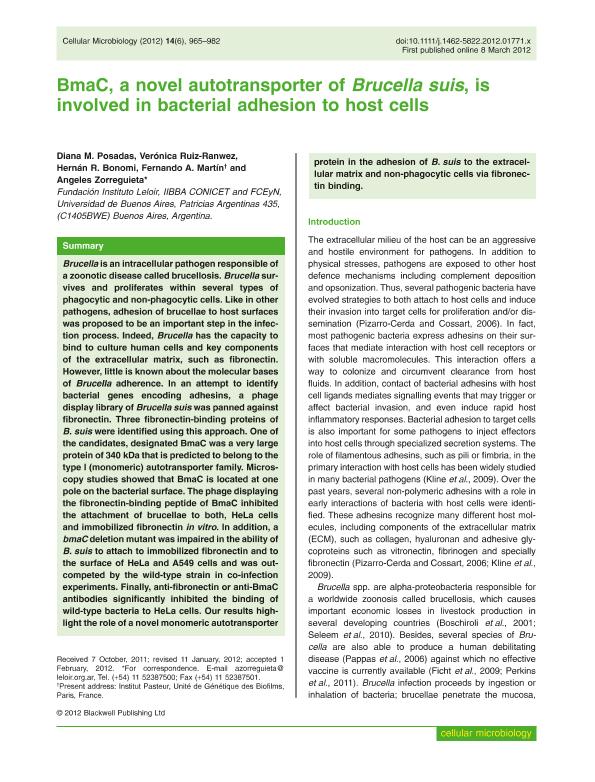Mostrar el registro sencillo del ítem
dc.contributor.author
Posadas, Diana Maria

dc.contributor.author
Ruiz, Veronica

dc.contributor.author
Bonomi, Hernan Ruy

dc.contributor.author
Martin, Fernando Ariel

dc.contributor.author
Zorreguieta, Angeles

dc.date.available
2017-06-16T19:39:23Z
dc.date.issued
2012-03
dc.identifier.citation
Posadas, Diana Maria; Ruiz, Veronica; Bonomi, Hernan Ruy; Martin, Fernando Ariel; Zorreguieta, Angeles; BmaC, a novel autotransporter of Brucella suis, is involved in bacterial adhesion to host cells; Wiley Blackwell Publishing, Inc; Cellular Microbiology; 14; 6; 3-2012; 965-982
dc.identifier.issn
1462-5814
dc.identifier.uri
http://hdl.handle.net/11336/18347
dc.description.abstract
Brucella is an intracellular pathogen responsible of a zoonotic disease called brucellosis. Brucella survives and proliferates within several types of phagocytic and non-phagocytic cells. Like in other pathogens, adhesion of brucellae to host surfaces was proposed to be an important step in the infection process. Indeed, Brucella has the capacity to bind to culture human cells and key components of the extracellular matrix, such as fibronectin. However, little is known about the molecular bases of Brucella adherence. In an attempt to identify bacterial genes encoding adhesins, a phage display library of Brucella suis was panned against fibronectin. Three fibronectin-binding proteins of B. suis were identified using this approach. One of the candidates, designated BmaC was a very large protein of 340 kDa that is predicted to belong to the type I (monomeric) autotransporter family. Microscopy studies showed that BmaC is located at one pole on the bacterial surface. The phage displaying the fibronectin-binding peptide of BmaC inhibited the attachment of brucellae to both, HeLa cells and immobilized fibronectin in vitro. In addition, a bmaC deletion mutant was impaired in the ability of B. suis to attach to immobilized fibronectin and to the surface of HeLa and A549 cells and was out-competed by the wild-type strain in co-infection experiments. Finally, anti-fibronectin or anti-BmaC antibodies significantly inhibited the binding of wild-type bacteria to HeLa cells. Our results highlight the role of a novel monomeric autotransporter protein in the adhesion of B. suis to the extracellular matrix and non-phagocytic cells via fibronectin binding.
dc.format
application/pdf
dc.language.iso
eng
dc.publisher
Wiley Blackwell Publishing, Inc

dc.rights
info:eu-repo/semantics/openAccess
dc.rights.uri
https://creativecommons.org/licenses/by-nc-sa/2.5/ar/
dc.subject
Bmac
dc.subject
Autotransporter
dc.subject
Brucella
dc.subject
Adhesion
dc.subject.classification
Biología Celular, Microbiología

dc.subject.classification
Ciencias Biológicas

dc.subject.classification
CIENCIAS NATURALES Y EXACTAS

dc.title
BmaC, a novel autotransporter of Brucella suis, is involved in bacterial adhesion to host cells
dc.type
info:eu-repo/semantics/article
dc.type
info:ar-repo/semantics/artículo
dc.type
info:eu-repo/semantics/publishedVersion
dc.date.updated
2017-06-12T20:59:45Z
dc.identifier.eissn
1462-5822
dc.journal.volume
14
dc.journal.number
6
dc.journal.pagination
965-982
dc.journal.pais
Reino Unido

dc.journal.ciudad
Londres
dc.description.fil
Fil: Posadas, Diana Maria. Consejo Nacional de Investigaciones Científicas y Técnicas. Oficina de Coordinación Administrativa Parque Centenario. Instituto de Investigaciones Bioquímicas de Buenos Aires. Fundación Instituto Leloir. Instituto de Investigaciones Bioquímicas de Buenos Aires; Argentina
dc.description.fil
Fil: Ruiz, Veronica. Consejo Nacional de Investigaciones Científicas y Técnicas. Oficina de Coordinación Administrativa Parque Centenario. Instituto de Investigaciones Bioquímicas de Buenos Aires. Fundación Instituto Leloir. Instituto de Investigaciones Bioquímicas de Buenos Aires; Argentina
dc.description.fil
Fil: Bonomi, Hernan Ruy. Consejo Nacional de Investigaciones Científicas y Técnicas. Oficina de Coordinación Administrativa Parque Centenario. Instituto de Investigaciones Bioquímicas de Buenos Aires. Fundación Instituto Leloir. Instituto de Investigaciones Bioquímicas de Buenos Aires; Argentina
dc.description.fil
Fil: Martin, Fernando Ariel. Consejo Nacional de Investigaciones Científicas y Técnicas. Oficina de Coordinación Administrativa Parque Centenario. Instituto de Investigaciones Bioquímicas de Buenos Aires. Fundación Instituto Leloir. Instituto de Investigaciones Bioquímicas de Buenos Aires; Argentina
dc.description.fil
Fil: Zorreguieta, Angeles. Consejo Nacional de Investigaciones Científicas y Técnicas. Oficina de Coordinación Administrativa Parque Centenario. Instituto de Investigaciones Bioquímicas de Buenos Aires. Fundación Instituto Leloir. Instituto de Investigaciones Bioquímicas de Buenos Aires; Argentina
dc.journal.title
Cellular Microbiology
dc.relation.alternativeid
info:eu-repo/semantics/altIdentifier/url/http://onlinelibrary.wiley.com/doi/10.1111/j.1462-5822.2012.01771.x/full
dc.relation.alternativeid
info:eu-repo/semantics/altIdentifier/doi/http://dx.doi.org/10.1111/j.1462-5822.2012.01771.x
Archivos asociados
